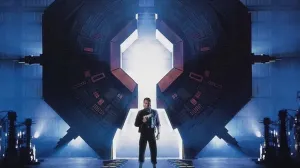The Fast & Furious franchise has evolved from humble beginnings into Hollywood’s premier showcase for automotive impossibility. When Dominic Toretto (Vin Diesel) and Brian O’Conner (Paul Walker) first raced through the streets of Los Angeles in 2001, the stunts remained within the realm of plausibility, focused on street races, precision driving, and the occasional dramatic jump. Fast forward to the newer installments, and we find cars parachuting from cargo planes, driving between skyscrapers, and even venturing into outer space. This dramatic escalation wasn’t accidental but represents a deliberate strategy by Universal Pictures to transform what began as a street racing series into a global action phenomenon that rivals superhero films in both spectacle and box office performance.
Videos by ComicBook.com
The turning point came with 2011’s Fast Five, when director Justin Lin consciously steered the series toward action spectacle over racing drama, creating a template for future installments to embrace even greater impossibilities. Since then, the franchise has consistently pushed the boundaries of what audiences will accept, creating signature moments where automotive physics takes a backseat to pure entertainment. The following seven scenes represent the pinnacle of the Fast & Furious saga’s physics-abandoning audacity.
The Nuclear Submarine Chase (The Fate of the Furious)
The Fate of the Furious delivers one of the franchise’s most absurd action sequences when Dom’s crew finds themselves pursued across a frozen Russian bay by a nuclear submarine. The scene culminates with Dom using his modified Dodge Charger to redirect a heat-seeking torpedo into the pursuing submarine. The submarine moves at impossible speeds while breaking through solid ice repeatedly, a maneuver that would damage or disable any real submersible. Then, the frozen surface somehow supports the weight of numerous high-performance vehicles driving at speeds exceeding 100 mph without cracking — ice thick enough to support vehicles would be far too dense for a submarine to surface through.
Most egregiously, Dom’s car maintains perfect traction on ice while performing precision maneuvers that would be challenging on dry pavement. Finally, the torpedo itself behaves unlike any real-world weapon, conveniently changing direction when needed and delivering a perfectly timed explosion.
The Vault Heist (Fast Five)
Fast Five features Dom and Brian attaching a massive bank vault to their Dodge Chargers and dragging it through the streets of Rio de Janeiro, using it as a wrecking ball against pursuing police vehicles. A bank vault of that size would weigh approximately 10 tons, creating enough momentum to either rip the attachment points from the muscle cars or simply drag the vehicles backward whenever they attempted to change direction. In addition, the precision control shown while swinging the multi-ton vault around corners defies the basic principles of inertia and momentum — the vault would continue in its original direction regardless of where the cars turned.
Plus, the street surfaces would be destroyed by the dragging metal, creating impassable trenches rather than the smooth path shown. Most improbably, the vault itself remains intact despite being dragged at high speeds over pavement, which would generate enough friction heat to compromise even hardened steel.
The Runway Takedown (Fast & Furious 6)
Fast & Furious 6 features an airport runway sequence where Toretto’s crew attempts to prevent a massive cargo plane from taking off. The sequence unfolds over what aviation experts have calculated would need to be a 26-mile runway, approximately 18 times longer than the world’s actual longest runway. The cars somehow match pace with an aircraft designed to reach takeoff speeds exceeding 150 mph, maintaining perfect formation at speeds most production vehicles cannot achieve.
To make matters more unbelievable, several vehicles tethered to the plane by harpoon cables somehow prevent it from becoming airborne, despite the fact that a cargo plane’s engines generate tens of thousands of pounds of thrust, which would easily overcome the minimal resistance provided by the cars. The cables would snap from tension or rip the attachment points from the cars’ frames before significantly impeding the aircraft. Finally, when the plane does crash, the protagonists miraculously outrun the massive fireball and debris field that would engulf everything in its path.
[RELATED: You Probably Haven’t Even Seen One of the Best Fast & Furious Movies]
The Mid-Air Rescue (Fast & Furious 6)
During Fast & Furious 6‘s tank chase sequence, Letty (Michelle Rodriguez) is thrown from an enemy tank across a highway bridge. Dom accelerates his car toward a guardrail, using it as a launching ramp to propel himself airborne, intercepts Letty mid-flight, catches her in his arms, and crashes through the windshield of another vehicle on the opposite side of the bridge. The precision timing required to calculate Letty’s trajectory and intersect with her in mid-air would be mathematically impossible for a human driver to execute in split seconds. The physics of projectile motion makes their mid-air intersection virtually impossible without computer-guided calculations.
Furthermore, the impact forces involved in two bodies colliding at high speed would likely cause serious injury rather than the gentle embrace depicted. Most improbably, both characters survive the subsequent crash, landing on another vehicle without suffering any significant trauma, despite forces that would shatter bones and cause severe internal injuries in reality.
The Skyscraper Jump (Furious 7)
Furious 7 shows Dom and Brian driving a Lykan HyperSport through three consecutive Abu Dhabi skyscrapers. After crashing through the windows of the first building, they accelerate toward the gap, launch across a massive chasm, and smash through another glass façade, only to repeat the feat to reach a third building. Modern skyscrapers are typically spaced too far apart for any land vehicle to bridge the gap, regardless of speed. The car’s structural integrity would be compromised by the initial impact with architectural glass and steel, making subsequent jumps impossible as the vehicle’s frame, alignment, and aerodynamics would be severely damaged.
In short, the precision required to align these jumps while inside a damaged vehicle with compromised visibility exceeds human capability. The scene concludes with the car running out of buildings to jump through and plummeting dozens of stories, with Dom and Brian somehow surviving the fall with only minor scratches despite an impact that would crumple even the most robust vehicle.
The Canyon Swing (F9)
F9 shows Dom and Letty trapped on a collapsing bridge, driving their car over a suspended cable and using it as a pendulum to swing themselves across a massive canyon to safety on the opposite cliff. First, the thin cable would snap under the combined weight of the vehicle and the force generated during the swing, as no steel cable of that diameter could support several thousand pounds of dynamic load. Then, the precision needed to navigate onto the cable at high speed would be impossible for human drivers to execute, requiring split-second timing and perfect alignment.
Finally, the impact forces when reaching the opposite cliff would demolish any conventional vehicle’s suspension system and likely cause fatal injuries to the occupants as the car’s crumple zones compressed violently. The characters emerge from this physically impossible scenario without injuries, airbag deployments, or even a damaged vehicle, suggesting they operate in a universe where Newton’s laws of motion are merely guidelines.
The DIY Space Program (F9)
F9 sends Roman Pearce (Tyrese Gibson) and Tej Parker (Ludacris) into actual outer space in a Pontiac Fiero retrofitted with rocket boosters, wearing only modified scuba gear as improvised space suits. This sequence abandons even the pretense of physical plausibility. The Pontiac Fiero lacks the structural integrity to withstand the forces of launch, with its fiberglass body certain to disintegrate during atmospheric exit. The improvised rocket boosters would generate insufficient thrust to achieve escape velocity (approximately 25,000 mph) and would more likely explode on ignition than produce controlled propulsion.
In addition, standard scuba equipment provides no protection against the vacuum of space, where blood would boil, lungs would rupture, and consciousness would be lost within seconds. The extreme temperature and radiation exposure would be immediately fatal without proper shielding. The reentry physics is equally impossible, as the unshielded vehicle would burn up completely during atmospheric reentry rather than safely splashing down in the ocean as depicted.
What other Fast & Furious scene would you add to this list? Let us know in the comments!








